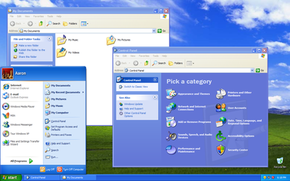| Windows XP | |
|---|---|
| Part of the Microsoft Windows family | |
 | |
| Screenshot of Windows XP | |
| Developer | |
|---|---|
| Microsoft Corporation | |
| Website | Windows XP: Homepage |
| Releases | |
| Release date | RTM: August 24, 2001 Retail: October 25, 2001 (info) |
| Current version | 5.1 (Build 2600: Service Pack 3) (April 21, 2008) (info) |
| Source model | Closed source, Shared source[1] |
| License | Microsoft-EULA |
| Kernel type | Hybrid |
| Update method | Windows Update |
| Platform support | IA-32, x86-64, Itanium |
Windows XP is an operating system that was produced by Microsoft for use onpersonal computers, including home and business desktops, laptops, and media centers. It was first released to computer manufacturers on August 24, 2001, and is the most popular version of Windows, based on installed user base. The name "XP" is short for "eXPerience."
Windows XP was the successor to both Windows 2000 and Windows Me, and was the first consumer-oriented operating system produced by Microsoft to be built on theWindows NT kernel and architecture. Windows XP was released for retail sale on October 25, 2001, and over 400 million copies were in use in January 2006, according to an estimate in that month by an IDC analyst. It was succeeded by Windows Vista, which was released to volume license customers on November 8, 2006, and worldwide to the general public on January 30, 2007. Direct OEM and retail sales of Windows XP ceased on June 30, 2008. Microsoft continued to sell Windows XP through their System Builders (smaller OEMs who sell assembled computers) program until January 31, 2009. XP may continue to be available as these sources run through their inventory or by purchasing Windows 7 Ultimate, Windows 7 Pro, Windows Vista Ultimate or Windows Vista Business, and then downgrading to Windows XP.
The most common editions of the operating system were Windows XP Home Edition, which was targeted at home users, and Windows XP Professional, which offered additional features such as support for Windows Server domains and two physical processors, and was targeted at power users, business and enterprise clients.Windows XP Media Center Edition has additional multimedia features enhancing the ability to record and watch TV shows, view DVD movies, and listen to music.Windows XP Tablet PC Edition was designed to run stylus applications built using theTablet PC platform.
Windows XP was eventually released for two additional architectures, Windows XP 64-bit Edition for IA-64 (Itanium) processors and Windows XP Professional x64 Editionfor x86-64. There is also Windows XP Embedded, a component version of the Windows XP Professional, and editions for specific markets such as Windows XP Starter Edition. By mid 2009, a manufacturer revealed the first Windows XP powered cellular telephone.
The NT-based versions of Windows, which are programmed in C, C++, and assembly, are known for their improved stability and efficiency over the 9x versions of Microsoft Windows. Windows XP presented a significantly redesignedgraphical user interface, a change Microsoft promoted as more user-friendly than previous versions of Windows. A new software management facility called Side-by-Side Assembly was introduced to ameliorate the "DLL hell" that plagues 9x versions of Windows. It is also the first version of Windows to use product activation to combat illegal copying. Windows XP had also been criticized by some users for security vulnerabilities, tight integration of applications such as Internet Explorer 6 andWindows Media Player, and for aspects of its default user interface. Later versions with Service Pack 2, Service Pack 3, and Internet Explorer 8 addressed some of these concerns.
During development, the project was codenamed "Whistler", after Whistler, British Columbia, as many Microsoft employees skied at the Whistler-Blackcomb ski resort
According to web analytics data generated by W3Schools, as of January 2011, Windows XP is the most widely used operating system for accessing the Internet in the world with a 45.3% market share, having peaked at 76.1% in January 2007.
No comments:
Post a Comment